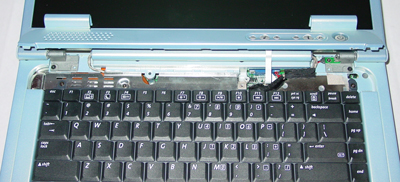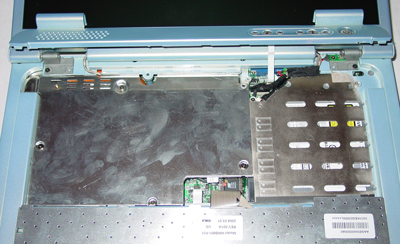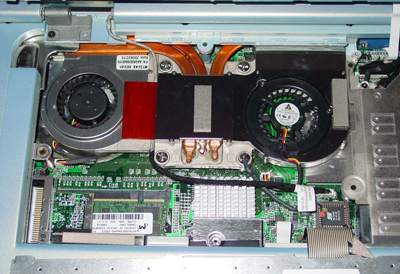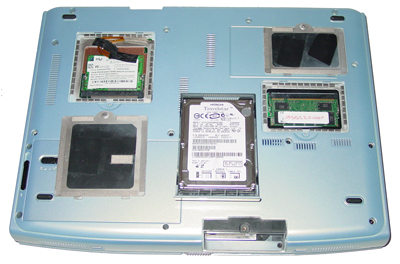Voodoo Envy M:860 - AMD 64-bit at Widescreen
by Andrew Ku on August 13, 2004 12:05 AM EST- Posted in
- Laptops
Construction - Upgrading and Maintenance
Performing maintenance on the M:860 is fairly straightforward and can be compared to some of the Compaq Presario notebooks that we have used. In order for the front bezel to be removed, the two middle screws on the bottom side need to be removed. After that, you need to use a flat head screwdriver to make a wedge between the bezel and the keyboard, and then jimmy the bezel out. It takes a while, since there are four tabs that hold it in place (two on each side - left and right, two on each side - top and bottom), in addition to the two screws. The issue that we take with this design is that you are bound to scratch up the bezel when you use a screwdriver to jimmy it out. What makes it worse is that the paint job is also likely to be scratched. A design like the 8600's bezel, where there is a slight depression on the casing, would help resolve this issue.It's probably easier to close the laptop first and kind of loosen one of the hinge portions of the bezel, and then open the laptop and loosen the bezel from the center, and work toward one of the hinges. From there, you should be able to loosen the hinge in the direction toward you.
Removing the keyboard for cleaning is a bit trickier than other notebooks that we have used, since the fit of the keyboard is a bit tighter and we had to wiggle it out, so you are just going to have to be patient when you have to do this.
There are four screws that hold the metal plate under the keyboard to the casing. Once the metal plate is removed, the vital components of the system come into view. Directly in the center is the heatpipe/dual cooler system for the Athlon 64 DTR 3400+, which can be cleaned by removing several more screws and jimmying it out. The Mobility Radeon 9700 GPU is located beneath an integrated heat spreader, which lies underneath the fan on the right and seems to be of the integrated memory package design. The heatsink in the center, meanwhile, covers the VIA K8T800 northbridge.
The main SODIMM slot is visible here, but is mainly inaccessible due to the placement of the card reader. You can still remove and add a SODIMM memory module to the slot here, but it is going to require nimble fingers and a bit of trick work with a screwdriver to unsecure the left side of the memory module and remove it from the right.
As mentioned before, the bottom side of the unit is home to an Intel WiFi 2200BG mini-PCI card, the other memory module, and the system's only hard drive. It seems that Voodoo is still choosing to use SODIMM DDR333 modules from Crucial, even though the K8T800 supports DDR400. We have been informed by Voodoo that they are still validating DDR400 for their notebook systems, since there have been some finicky systems. We should note that Dell is already using SODIMM DDR400 modules in their Inspiron XPS systems, so in this spot, Voodoo seems to be a bit behind the competition (including Alienware). The switch probably won't happen for a couple of months, so you can either choose to buy now and buy the SODIMM DDR400 modules from Voodoo (probably at a little above or at cost) or from someone else and upgrade yourself or hold off completely and wait to buy later.














17 Comments
View All Comments
muddywater - Thursday, April 14, 2005 - link
Here goes my review of the Voodoo M:855I bought one of the first M:855s and while it is possible mine is just a lemon, it has been the most unstable machine I have ever worked with, and I have worked with alot (since the mid 80's). The DVD drive only successfully burned 1 DVD out of hundreds of attempts (with various software and various media).It occasionally decides that it will not read any CD-ROM's or CD-R's, though it will still read a DVD or burn a CD just fine. I get lots of seemingly random crashes and corrupted files. I was running XP and SUSE on it previously but at the moment I am running XP and Win2k Server (for development purposes). It is definitely fast for a notebook, but will usually shut down (no warning or error given) if I start running anything that needs serious processing power (Games and GIS software which are the only things I really need it for). It seems to be a cooling problem because you can usually hear the fan speed up to full throttle before the crash . Propping it up to get more air to the intake on the bottom seems to increase the run time before crash or shutdown. External video output works periodically. Moving the LCD display will sometimes make the external output start functioning again.
The custom paint job is beautiful and has held up far beyond expectations, but I had ordered the computer without an embedded tattoo, and they shipped it with one, so I ended up scraping it off with a knife (so much for the nice paint job). I am happy with the touchpad and keyboard, but the keyboard (or display) is not recessed enough so the rubbing has scraped key outlines onto the screen(haven't had that prob on my other notebooks). Wireless range is lousy though that can be easily remedied with a PC Card adapter if range is important to you. Speakers are the most pathetic I have ever run across (I guess they expect that most gamers will have a nice set of headphones for mobile use). Battery life is great as they claimed it would be. The video card is supposedly upgradable though I have yet to check if there will actually be any upgrades available that will work in it. I hope the rest of you have had a better experience with your mega $$$ VoodooPC's
-Muddywater
Myrandex - Monday, August 16, 2004 - link
I think I know the real reason behind the choice of DDR333. There have been numerous Emachines discussions (I think I first stumbled upon this at the [H] forums), and there is some bug with the Arima design. Supposedly it is only validated for DDR400 with a single stick, and with two DDR400 sticks, it is instable or something like this. I have an Emachine M6805, and I also agree it is basically the same notebook. I wish AT woulda reviewed the Emachine notebook back in the Spring when it came out, as this would look like old news (its a 6811 with the faster hard drive and a Radeon 9700 instead of 9600). Hopefully that means there will be a Emachines notebook with a 9700 instead of 9600. Being 64bit ready is a plus when choosing any notebook based on the A64, as I enjoy dual booting SuSe 64bit edition to at least try to learn Linux a little bit.Jason
Mook1e - Monday, August 16, 2004 - link
I would love to see a comparison of this machine and the Emachines M6811. The machines are very similar in design with the only differences being slight external cosmetic diff. and the higher res. lcd and m11 vice m10. I've had my m6809 for over 4 months and with over 50,000 miles of use have had no problems (not even hinges) I would recommend the brand to anyone as long as they make sure they get one with the "new" hinges. I’ve played plenty of Far Cry and Doom3 on my m6809 and it runs great. (800x600 med detail for Doom3 and 800x600 high detail for Far Cry) Is there any possibility of a comparison of these machines? It seems that you get about 90% the performance for almost 1/3 the price ($3300 for Voodoo and $1400 for Emachines)AndrewKu - Sunday, August 15, 2004 - link
#12/13 - My fault on the dual channel bit. My line of thought was actually was with the Inspiron XPS and Alienware 51-M in terms of comparison and the DTR market as a whole and I slipped up on that one. It is fixed now; I clarified my run away train of thought. :) Sorry… If you only knew the lack of sleep we (editors) get… :pBut I stand by the rest of what I said. You need to keep in mind that memory designs and integration for notebooks are very different than those for a desktop. Manufacturers are much more conservative in their notebook's motherboard designs. I actually had a chat about this with Derek our CPU editor and Wes our Memory editor as to the possible implications of DDR400 with this machine + this is based on our conversations with Rahul Sood of Voodoo (the grande honcho over there) on their choice of memory. So as far as that goes, we did put a lot of thought on the other stuff you mentioned as possible errors. I hope that helps a bit.
As for the function key, I do understand that some like it this way, but this is not the majority as far as studies have said. That is why the big three: IBM, HP/Compaq, and Dell do it the “right way.” Whether it is really right for the sake of actually being right that is up for debate. :)
mino - Saturday, August 14, 2004 - link
Andrew: jet another hardly misleading sentence:"Because of the architectural difference between Intel and AMD systems, there probably won't be any performance increase with DDR400 in general application use for Voodoo's M:860, but there should be some in gaming and memory bandwidth dependent scenarios."
Actually it IS crucial to K8 architecture to have fast memory since the whole performance of A64 relies on low latency. I would bet with DDR400 modules, meassured difference in performance between 860 and desktop 3400+ would be cut to 1/3.
I suggest you study some articles about A64's for instance on AT, since you apparently understand notebooks, but DON'T understand A64 architecture.
Or just try to not comment about things You don't understand;)
I hope we will see some Mobile A64 35/25W TDP soon.
mino - Saturday, August 14, 2004 - link
", we won't handicap the system by removing a stick, especially since dual channel is one of the benefits in a DTR system"Andrew: Just repair that typpo that it is an dual channel config, you also stated "K8T800" supports DDR400. It looks then like you had no idea about the A64 achitecture.
3400+ is socket754 SINGLE ch. proc. and chipset in any A64 machine does have nothing to do with supported memory type.
Except these typpos, nice review.
And, about the "incorrect function key placement": many guys forgot that there ARE people around(like me) that like it and hate FN right to CTRL. It's simply personal prefference.
EdvardGrieg - Saturday, August 14, 2004 - link
That really annoys me that Voodoo can't fix the function key issue, that is a real deal breaker for me. Even the newer Compaq A64 laptops that appear to have the same keyboard layout (delete key etc) have the ctrl key in the right spot. I ended up choosing an HP over that Compaq though, because surprisingly (because they're the same company) the Compaq had a different keyboard which just felt 'cheap' in comparison to the HP. Looking at the pictures etc, the touchbad appears to be identical to HP and Compaq's offerings as well.As far as 'access' goes, I have to sing the praises of HP for a second, my laptop (zt3340), there is standard access to HD, one memory slot and mini-pci on the bottom, to remove the keyboard though, you unscrew two screws (Which are clearly labeled no less) on the bottom, and then you slid down four little latches at the top of the keyboard and it pops right out to reveal the other memory slot etc. Brilliant engineering IMHO as there is no prying and the keyboard fits in seamlessly.
AndrewKu - Friday, August 13, 2004 - link
#8 - If you read the context of what I wrote, I did not compare the A64 to Dothan. I put that reference in because this is our first notebook review that I have written in a few months and that is very relevant information to the industry. So I am assuming you are talking about Anand’s review: http://www.anandtech.com/cpuchipsets/showdoc.aspx?... and Dothan is special in the sense that it is an upgrade from Banias that brings more performance benefits while lower some of the power requirements, clock for clock, at the same time. There is a reason that the big three choice system vendors choose Dothan/Banias/Pentium-M over mobile AthlonXP for at least a majority of their systems if not all: power consumption, performance, and their notebook design’s thermal budget.Icy006 - Friday, August 13, 2004 - link
I own an e-machines M6805. Same platform as m:680 (and the predecessor to the e-machines M6811).Brought it to a weekend lan party recently, and it played all my games great (doom3, call of duty, worms armageddon :), UT2004, etc). I'm in 64-bit Gentoo Linux on it right now, and I love it even more as a portable development machine.
At some Best Buy locations, you can get the M6805 for $1150 after $250 in two rebates (before tax). If you are considering the Voodoo Envy, give the E-Machines a look first. It does not match specs, but it gets damn close for literally 1/3 the price. All that really needs replacing is the 4200 rpm hard drive with a 7200 rpm. I overclocked my mobility radeon 9600 from core clock 300MHz to 450MHz, and get about 11800 in 3dMark 2001SE.
The ram, CPU, video, rom, and screen res differences are all subjective matters of preference. Both machines perform wonderfully. Also, the CPU in the M6805 is a Mobile 3000+, not a DTR, so it uses ~20 watts less at full power (but still has full 1MB L2 cache).
justauser - Friday, August 13, 2004 - link
What's so special about a Dohan? (Your cliff notes reference).Dohan looks very much like a mobile AthlonXP to me - just try running one under load and you see power goes way up (not just playing a DVD, all modern processors can do that without breaking a sweat).
Just compare say a Barton-core mobile XP and a Dothan and tell me where the differences are - apart, that is, from the price of an XP at <$100 and Dothan more than six times as much.
Come on, I'd like to see a comparison. How about it (and don't include an Athlon64, that's a horse of a very different color).